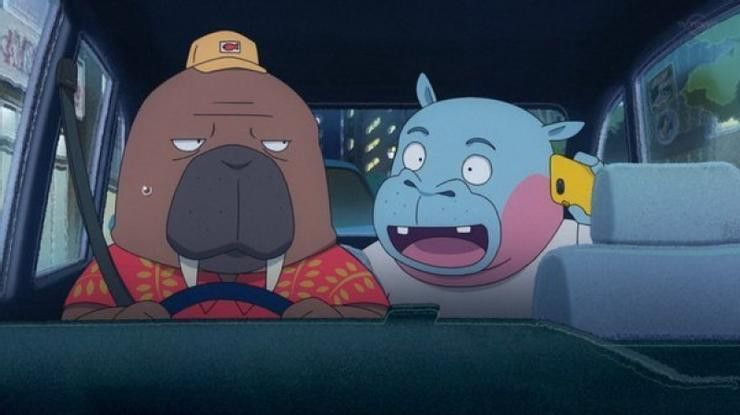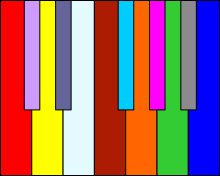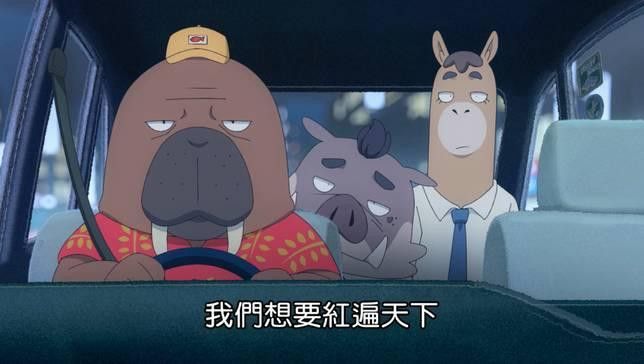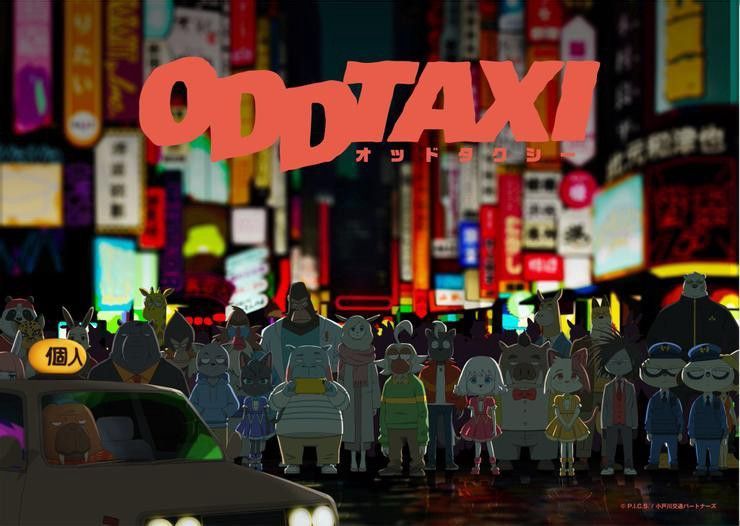
畢業於中正大學心理和哲學系,現就讀陽明交通大學社會與文化研究所。曾在關鍵評論網擔任書評專欄作者。文章主要投稿、刊登於 香港 微批paratext 或 虛詞.無形網站,多為文學、哲學類性質。另也有動漫評論發表於U-ACG。 信箱:f0921918962@gmail.com 信箱:f0921918962@gmail.com
Talking about "Kit Kat Taxi": Maybe we all need a kind of "visual agnosia"
KitKat Taxi is an anime that will be released in spring 2021. The content mainly tells the tortuous story of a taxi driver, Otogawa, who was involved in various incidents, dealing with people from all sides, and finding the truth. Although it is not as good as "86-Non-Existing Battlefield" or "Vivy-Fluorite Eye's Song-" of the same period, the content itself is quite good-looking and exciting. Each character in it is quite interesting, and like their different animal shapes, they have their own distinct characteristics.
In a way, "KitKat Taxi" is a bit like a group drama. Inside, through the eyes of a walrus taxi driver, we saw the stories of ordinary people of different occupations, and saw their inner confusion, how they finally converged and intersected in the city because of their respective actions, as if they were chasing each other. All kinds of interesting interactions.

Another interesting point of this anime is that, as mentioned earlier, this work is very similar to "Animal City" or "Beastars", people do not appear in the appearance of people, but become different species. Animals interact with each other, showing a kind of "animal society" to discuss various issues of racial or gender discrimination hidden in human society.
"KitKat Taxi" has completely gone out of its own unique way. Different from the previous two works, each animal in this is actually not the real appearance of the characters, but the appearance of "people" in the eyes of the protagonist Otogawa. The explanation given by the animation is that because the protagonist had an accident that caused him to suffer from visual agnosia, in his eyes, everyone could not appear in front of him as a person, but became similar according to Otogawa's impression of them. Temperament of animal images to show.

Visual agnosia is a high-functioning cognitive impairment in the brain. A person suffering from this disease will not lose his sight. On the contrary, he may still have good vision and can drive like Otogawa, but what is he seeing? However, it has a different cognition than ordinary people, and even can't answer, and loses the normal ability to understand what they see.
For example, a person with agnosia may see the chair in front of him, but cannot tell that it is a chair. This does not mean that he has forgotten the word "chair", because when reading novels, he can fully understand exactly what "sit down on a chair" means, and when asked what "chair" is, he can even draw Chair to show. But if he were asked to look at the chair to answer what it was, he couldn't say it, or he would say something else (eg: an object with four legs).
The patient has lost the ability to recognize and recall vision, or, the cognitive ability to recognize visual stimuli. Vision becomes unable to cooperate and coordinate with past memories, but part ways, as if they are independent. This kind of agnosia is also divided into several types, the common ones are apperception agnosia, associative agnosia, prosopagnosia (commonly known as face blindness) and so on. The anime says that Otogawa belongs to the second category, but it seems a bit wrong, because the general definition of associative agnosia is that patients can distinguish complex shapes and recognize the nature of objects, but cannot name or name objects. Associating with the functional meaning of objects. His visual perception and language systems were separated.
In the end, the reason why agnosia is called agnosia is that it has a lot to do with language. Like prosopagnosia, you can see the person, but you can't remember (recognize) who he is, but you may know who he is right away when you hear his voice. But Otogawa doesn't look like this. He obviously knows who the people around him are, and he also understands that they are actually people, but they just look like animals in his own eyes.
In this way, Odogawa's feelings towards people are actually more like another state: synesthesia. Refers to the phenomenon that when one of the human senses is stimulated, another or more senses that are not stimulated will also react at the same time. For example, when hearing a specific letter or song, the perception of seeing a specific color will occur; or when seeing certain colors, there will be salty, sweet, etc. tastes followed.

This phenomenon of "synesthesia" has triggered the creative thinking of some artists, especially the famous poet Han Bo, who once called this kind of synesthesia a kind of psychic, and believed that all poets should become communicators of the senses. Spiritualist, and therefore wrote his famous poem: "The Color of Vowels":
"I invented the colors of vowels, A black, E white, I red, O blue, U green. I determined the gestures and movements of each consonant, and one day or another, I used natural rhythms to create a Poetry and language accepted by all the senses... If you are a chef, the words will have various flavors, the dancer's words will have various gestures and dance, the painter's words will have various shapes and colors, and the musician's words will be like a staff Words..."
The Japanese poet Shuntaro Tanigawa's poem "The Breath of Color" also has a similar feeling of synesthesia, which describes the "breath" of various colors. But back to the owner of the KitKat taxi, Otogawa feels that the people he sees are associated with various animals according to their impressions and temperaments.
What's interesting is that he can't see what these people really look like, but he seems to be able to "see" people better than anyone else. Although ordinary people can see the real appearance of people, it seems that they are more likely to fall into the deception of various appearances than Odogawa. "Visual agnosia" has become a metaphor, implying that our society has never been what it seems on the surface. Only by letting ourselves fall into a "visual agnosia" can we escape the deception of appearances. What Otogawa sees is not the appearance of people, but the self that people dare not express and hide in their hearts.
Most of the characters in KitKat Taxi, although working in different places, actually have similar troubles. They all seem to be trapped by what they are after, but they do not realize that what they are after, although it seems beautiful, is actually just an illusion. College student Huazawa wants to become an internet celebrity, Persimmon wants to have money to get love, Nichiado and Yamamoto want to become a popular idol group, Tanaka wants to have a sense of self-confidence and accomplishment from rare animals in mobile games, and Imai Put all your meaning on the Mystic Kiss idol group, Homo sapiens partner hoping to become famous...etc.

Huazawa's statement may be ridiculous, but the idea may be the yardstick by which many corporate marketers judge their own or others' success. With the vigorous development of social media in recent years, the speed of life has accelerated, the explosion of daily information has grown, and the trend of attaching importance to marketing and publicity has become stronger and stronger. This makes the times seem to be more and more progressive and efficient, but may instead make people more and more lonely and lonely. In order to attract other people's attention, people are funny, and they play various images that are completely inconsistent with their reality to get traffic, likes, and sponsorships, but they do not realize that their real self has been slowly hollowed out by meaningless data. Maybe at the beginning, everyone just wanted to do what they wanted to do well (like a Homo sapiens partner), but when they gradually found that their favorite things could not attract the attention of most people, they succumbed to the social popular system and created people The illusion that people love to watch and forget what their favorite things mean to them. People who are unable to attract others choose mobile games or star chasing to eliminate their inner discomfort, and gradually indulge in them day by day. They regard idols, rare things in mobile games, and online presentations as their full meaning, and avoid being in the dark. The setbacks in reality are only for the pursuit of illusory recognition and fame and fortune.


Modern people seem to want to be recognized all the time, but is it really that important to become famous and famous? In another scene, Tanaka, who was armed with a gun, came to the hotel to seek revenge on Otogawa. Shibagaki, the working partner of Homo sapiens, did not run away, but ran over to talk to Tanaka, not because he wanted to stop the shooting, but because he felt moral This is an opportunity to become famous. After the incident, he even came to the media to break the news, and he made up his "story" of trying to stop the gunman in the hotel, and then fabricated his fearful mood changes and feelings at the time, etc., and hoped that the media would report it.
We often say that modern society is a society that is constantly changing, and we encourage people to pay attention to and cherish all kinds of fleeting moments. However, perhaps the "now" is just an illusion, because the "now" is always fabricated by people. People can't live in the real moment of the present, but they want to shape the various moments as a situation of experiencing a certain "now". Attractive. Through mobile phones and the Internet, people are happy that they can record different moments at any time, but what they did not expect is that this does not make people more open, but transforms into a kind of self-surveillance, which makes everyone start to examine their own various "Fragments" are packaged into various "presents". We can even say that "moment" and "now" were actually "invented" by people after the advent of photography and film. Because before mobile phones and photography appeared, the meanings of the two words were probably very different to people. To people of the past, a moment probably would not have been an appearance.
But for modern people, "moment" not only often expresses itself in a superficial way. It even affects our perception of other things. Through the "moment" of thinking, even "justice" and "evil" are a "moment", and they must become an appearance to manifest themselves in order to prove themselves. It makes people think that as long as they say what they say on the Internet, what he represents. The most frequently seen articles on punishing evil and promoting good, or fan albums set up by politicians for themselves (in which they write various "snippets" of their own reflections today), etc., are all techniques to create appearances. How to imagine another real present in the "now" and "moment" of various modern information packaging may be more and more important to people.
Back to "Kit Kat Taxi", who is the "visual agnostic" in the end? Through Otogawa's funny but precise complaints, "KitKat Taxi" satirizes the absurd psychology behind people's "watching" and "being watched" in modern society, who want to become popular and famous. See everyone's self lost in the modern age. At the end, Otogawa released his state of "visual agnosia". We finally saw his past and understood why everyone was an animal in his eyes, and the film also brought us to see all the other characters again. "true appearance". It seems that this is a kind of relief or healing of trauma, but the author's arrangement may be asking us whether this is really a good thing? Because maybe, just like Otogawa, we also need a kind of "visual agnosia" to help ourselves not to get lost in the appearance of chasing~

(This article is simultaneously published on the square grid blog: Literature Lab )
FB Fan: https://pse.is/TCBRA
IG account: https://www.instagram.com/bungoussteins/
Like my work?
Don't forget to support or like, so I know you are with me..
Comment…